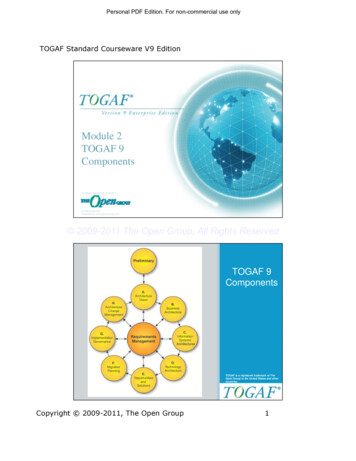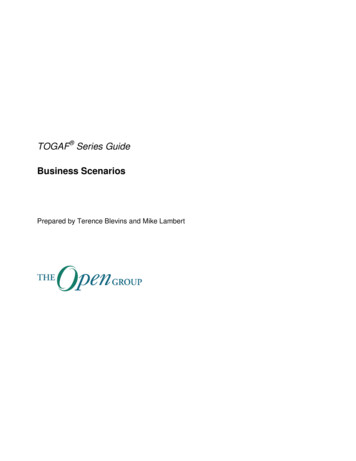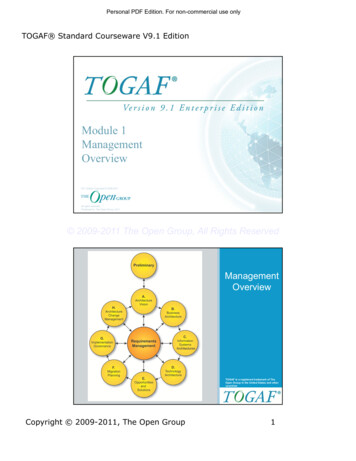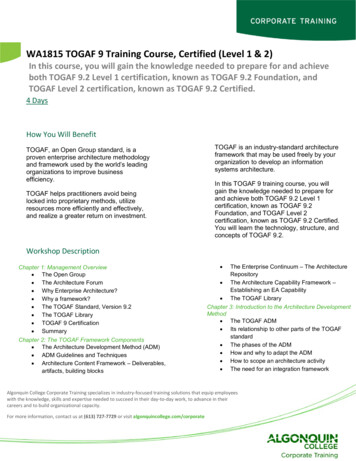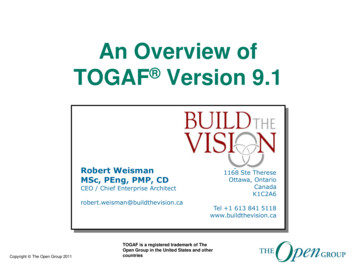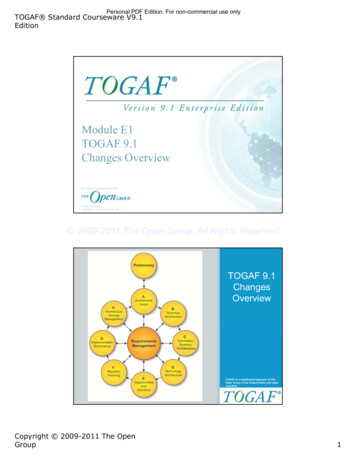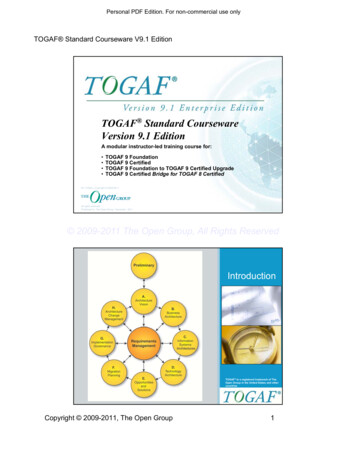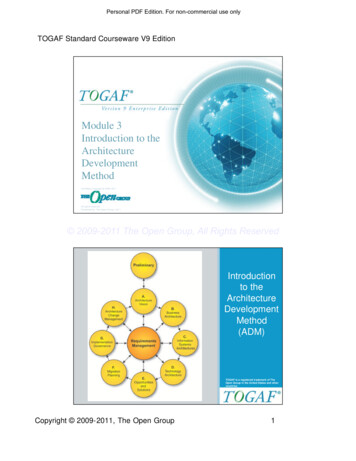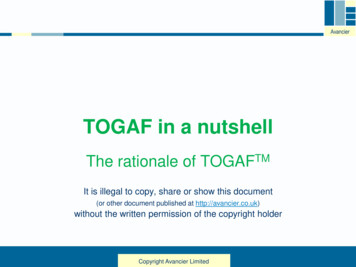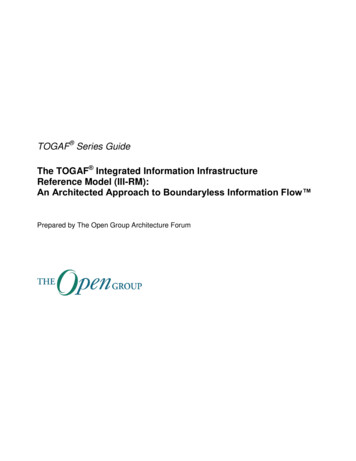
Transcription
Continue
Togaf 9.2 book pdf download torrent hd movieArchitecture descriptions will normally be built with a specific purpose in mind — a specific set of business drivers that drive the architecture development — and clarifying the specific issue(s) that the Architecture Description is intended to help explore, and the questions it is expected to help answer, is an important part of the initial phase of theADM. Timing . 2.1 What is the TOGAF Standard? Technical Integration/Interoperability includes common methods and shared services for the communication, storage, processing, and access to data primarily in the application platform and communications infrastructure domainsThis interoperability is premised upon the degree of rationalization of the corporate IT infrastructure, based upon standards and/or common IT platforms. 9.3.8 9.3.9 Finalize the Data Architecture Select standards for each of the building blocks, re-using as much as possible from the reference models selected from the Architecture Repository Fully document each building block Conduct a final cross-check of overall architecture against business requirements; document the rationale for building block decisions in the architecture document Document the final requirements traceability report Document the final mapping of the architecture within the Architecture Repository; fromthe selected building blocks, identify those that might be re-used, and publish via the Architecture Repository Finalize all the work products, such as gap analysis Create the Architecture Definition Document Document the rationale for building block decisions in the Architecture Definition Document. It will often be apparent that current systems,standards, or practices would be incongruent with the principle upon adoption. For large complex enterprises, federated architectures — independently developed, maintained, and managed architectures that are subsequently integrated within an integration framework — are typical. Iteration 1 Define the Target Architecture. They are explained,and an example set given, in Part III, Chapter 20. What is an enterprise? Use-Case Models can describe either business processes or systems functions, depending on the focus of the modeling effort A use-case model describes the business processes of an enterprise in terms of use-cases and actors corresponding to business processes andorganizational participants (people, organizations, etc.). Not for redistribution 37 ADM Overview Introduction to Part II While using the ADM, the architect is developing a snapshot of the enterprise’s decisions and their implications at particular points in time. The major information areas managed by a governance repository should contain thefollowing types of information: Reference Data (collateral from the organization’s own repositories/Enterprise Continuum, including external data; e.g., COBIT, the IT4IT Reference Architecture): used for guidance and instruction during project implementation This includes the details of information outlined above. Develop Architecture Vision. The key is to focus on the final target while realizing incremental business value. Not for redistribution 149 Objectives 14.1 Phase G: Implementation Governance Objectives The objectives of Phase G are to: 14.2 Ensure conformance with the Target Architecture by implementation projects Performappropriate Architecture Governance functions for the solution and any implementation-driven architecture Change Requests Inputs This section defines the inputs to Phase G. In addition, there are business drivers for architecture change, including: Business-as-usual developments Business exceptions Part II: Architecture Development Method(ADM) 2005-2018 The Open Group, All Rights Reserved Personal PDF Edition. 146 The Open Group Standard (2018) 2005-2018 The Open Group, All Rights Reserved Personal PDF Edition. Triggers . Normally used in the phrases Technology Roadmap, Architecture Roadmap, etc.Should succinctly and unambiguously communicate the fundamental rule. 12.3.6 Refine and Validate Dependencies Refine the initial dependencies, ensuring that any constraints on the Implementation and Migration Plans are identified. Architectural Inputs . Not for redistribution ArchitectureVision 3.19 Definitions Architecture Vision A succinct description of the Target Architecture that describes its business value and the changes to the enterprise that will result from its successful deployment. Our diverse membership of more than 580 organizations includes customers, systems and solutions suppliers, tools vendors, integrators,academics, and consultants across multiple industries. The set of services must be tested to ensure that the functionality provided meets application requirements. Those business capabilities should be mapped back to the organizational units, value streams, information systems, and strategic plans within the scope of the Enterprise Architectureproject. Accountability is the assignment of specific and appropriate responsibility, recognition of measurable expectations by all concerned parties, and alignment of decision-making with areas of responsibility and with where the impact of the decisions will be felt Accountability is aligned with the area where the benefits of success orconsequences of failure of the endeavor will be felt as well as with the responsibility areas. 12.3.8 Formulate Implementation and Migration Strategy Create an overall Implementation and Migration Strategy that will guide the implementation of the Target Architecture, and structure any Transition Architectures. Data is the foundation of ourdecisionmaking, so we must also carefully manage data to ensure that we know where it is, can rely upon its accuracy, and can obtain it when and where we need it. The steps in Phase G are as follows: 14.3.1 Confirm scope and priorities for deployment with development management (see Section 14.3.1) Identify deployment resources and skills(see Section 14.3.2) Guide development of solutions deployment (see Section 14.3.3) Perform Enterprise Architecture Compliance reviews (see Section 14.3.4) Implement business and IT operations (see Section 14.3.5) Perform post-implementation review and close the implementation (see Section 14.3.6) Confirm Scope and Priorities forDeployment with Development Management Review migration planning outputs and produce recommendations on deployment Identify Enterprise Architecture priorities for development teams Identify deployment issues and make recommendations Identify building blocks for replacement, update, etc. 175 The Open Group Standard (2018) 2005-2018 The Open Group, All Rights Reserved Personal PDF Edition. Legal Environment . 3.71 Solutions Continuum A part of the Enterprise Continuum. Consolidated Gaps, Solutions, and Dependencies Matrix. A poor set of principles will quickly become disused, and theresultant architectures, policies, and standards will appear arbitrary or self-serving, and thus lack credibility. Not for redistribution Migration Planning Techniques Architecture Definition Increments Table Architecture Definition - Project Objectives by Increment (Example Only) Project April 2018/2019 April 2019/2020 April 2020/2021 TransitionArchitecture 1: Preparation Transition Architecture 2: Initial Operational Capability Transition Architecture 3: Benefits Enterprise e-Services Capability Training and Business Process e-Licensing Capability e-Employment Benefits IT e-Forms Design and Build IT e-Information Environment Design and Build Information Environment Client CommonData Web Content Design and Build Enterprise Common Data Component Management Design and Build . Is that person capable of being a credible advocate or agent of the proposed Enterprise Architecture initiative? Process Status: all information regarding the state of any governance processes will be managed Examples of this includeoutstanding compliance requests, dispensation requests, and compliance assessments investigations. Architecture Compliance Review Guidelines . The implications of this consolidation of requirements with respect to architectural components can be significant with respect to the provision of resources. Hardware andOperating System Checklist . Stakeholder Power Grid. Subsequent Architecture Development iterations attempt to correct and refine the target to achieve an outcome that is beneficial, feasible, and viable. The order of the steps in Phase F as well as the time at whichthey are formally started and completed should be adapted to the situation at hand in accordance with the established Architecture Governance. A forum with comprehensive enterprise-wide representation should decide on process changes suggested by the steward Since data is an asset of value to the entire enterprise, data stewardsaccountable for properly managing the data must be assigned at the enterprise level Principle 11: Data is Shared Statement: Users have access to the data necessary to perform their duties; therefore, data is shared across enterprise functions and organizations. Understanding the readiness of the organization to accept change, identifying the issues,and then dealing with them in the Implementation and Migration Plans is key to successful architecture transformation in Phases E and F. 3.44 Information Any communication or representation of facts, data, or opinions, in any medium or form, including textual, numerical, graphic, cartographic, narrative, or audio-visual forms. Architecture Contract. Levels of Architecture Conformance. In many cases the architecture continues to fit, but the solutions underlying them may not, and some changes are required. Develop Statement of Architecture Work; Secure Approval . Identify any constraintson the Technology Architecture (especially the infrastructure) about to be designed. If unnecessary detail is included, the architecture effort may exceed the time and resources available, and/or the resultant architecture may be confusing or cluttered. Views, Tools, and Languages . Abstraction in thissense is typically used in architecture to allow a consistent level of definition and understanding to be achieved in each area of the architecture in order to support effective communication and decision-making. A common reaction on first reading of a principle is "this is obvious and does not need to be 200 The Open Group Standard (2018) 20052018 The Open Group, All Rights Reserved Personal PDF Edition. 11.2.1 11.2.2 11.2.3 Reference Materials External to the Enterprise Architecture reference materials (see Part IV, Section 32.2.5) Product information on candidate products Non-Architectural Inputs Request for Architecture Work (see Part IV, Section 32.2.17) CapabilityAssessment (see Part IV, Section 32.2.10) Communications Plan (see Part IV, Section 32.2.12) Architectural Inputs Organizational Model for Enterprise Architecture (see Part IV, Section 32.2.16), including: — Scope of organizations impacted — Maturity assessment, gaps, and resolution approach — Roles and responsibilities for architectureteam(s) — Constraints on architecture work — Budget requirements — Governance and support strategy Tailored Architecture Framework (see Part IV, Section 32.2.21), including: — Tailored architecture method — Tailored architecture content (deliverables and artifacts) — Configured and deployed tools 120 Technology principles (see Part III,Section 20.6.4), if existing The Open Group Standard (2018) 2005-2018 The Open Group, All Rights Reserved Personal PDF Edition. It encourages users to work within the integrated information environment instead of developing isolated systems to accomplish the task outside of the enterprise’s integrated information environment. For example,the Balanced Scorecard technique is a best practice performance measurement tool used by business schools and many organizations that can be used successfully in architecture projects. It is also important to predict the future uses of the architecture so that, within resource limitations, the architecture can be structured to accommodate futuretailoring, extension, or reuse. When using the TOGAF standard to support a specific architectural style the practitioner must take into account the combination of distinctive features in which architecture is performed or expressed. Inputs. Ensure that the systems developmentmethod enables feedback to the architecture team on designs Guide Development of Solutions Deployment Formulate project recommendation For each separate implementation and deployment project, do the following: — Document scope of individual project in impact analysis — Document strategic requirements (from the architecturalperspective) in impact analysis — Document Change Requests (such as support for a standard interface) in impact analysis — Document rules for conformance in impact analysis — Document timeline requirements from roadmap in impact analysis Document Architecture Contract — Obtain signature from all developing organizations andsponsoring organization 152 Update Enterprise Continuum directory and repository for solutions Guide development of business & IT operating models for services Provide service requirements derived from Enterprise Architecture Guide definition of business & IT operational requirements Carry out gap analysis between the SolutionArchitecture and operations Produce Implementation Plan The Open Group Standard (2018) 2005-2018 The Open Group, All Rights Reserved Personal PDF Edition. The metamodel must provide a basic model with the minimum feature set and then support the inclusion of optional extensions during engagement tailoring. Not for redistribution247 Determining Interoperability Requirements Interoperability Requirements between stakeholders and/or organizations (e.g., in defense the term is "operational node"), and the Data Architecture specifies the information shared between systems. Catalogs, Matrices, and Diagrams Organization Decomposition diagram Organization/Actor catalogLocation catalog Application and User Location diagram Business Capabilities catalog Capability/Organization matrix Business Capability Map Strategy/Capability matrix Capability/Organization matrix Enterprise Security (Corporate Functions); e.g., Corporate Risk Management, Security Officers, IT Security Managers Ensuring that the KEYinformation, data, and PLAYERS systems of the organization are available to only those that have permission, and protecting the information, data, and systems from unauthorized tampering. Organization-Specific Guidance and Techniques Where resources within the Library apply to the deployment of the TOGAF ADM and make explicit reference to"anchor points" within the TOGAF standard they are classified within the Library as Dependent documents. 479 Appendix B Abbreviations. Segment Architecture provides an organizing framework for operational and change activity and allows for direction setting and the development ofeffective architecture roadmaps at a program or portfolio level. An example is shown in Figure 24-5. Architecture Governance: Overview . Have recent changes been made that impact the Application Architecture? Name Statement Rationale Implications Should both represent the essence of the rule as well as beeasy to remember. Addressing a distinctive style should not call for significant changes to the TOGAF framework; instead it should adjust the models, viewpoints, and tools used by the practitioner. 16.5.3 Resources The world of requirements engineering is rich with emerging recommendations and processes for Requirements Management. TheseSBBs may have a one-to-one or many-to-one relationship with Part II: Architecture Development Method (ADM) 2005-2018 The Open Group, All Rights Reserved Personal PDF Edition. 6.3.10 Identify the Business Transformation Risks and Mitigation Activities Identify the risks associated with the Architecture Vision and assess the initial level ofrisk (e.g., catastrophic, critical, marginal, or negligible) and the potential frequency associated with it. 3.18 Architecture Viewpoint A specification of the conventions for a particular kind of architecture view. The goal is to deliver desired outcomes and adhere to relevant principles, standards, and roadmaps. Organizing the Architecture Landscape toUnderstand the State of the Enterprise . Once requirements for the current ADM cycle have been finalized then the Architecture Requirements Specification should be updated. Not for redistribution 229 Introduction 22.1.2 Architecture Patterns Content of a Pattern Several different formats areused in the literature for describing patterns, and no single format has achieved widespread acceptance. This initial Business Architecture Roadmap will be used as raw material to support more detailed definition of a consolidated, cross-discipline roadmap within the Opportunities & Solutions phase. The intent is to first establish what constitutesbusiness value within the organization, how value can be measured, and then apply this to each one of the projects and project increments. Confirm and Elaborate Architecture Principles, including Business Principles . Principle 13: Data Trustee Statement: Each data element has a trusteeaccountable for data quality. Purpose . A key objective is to re-use existing material as much as possible. They reflect a level of consensus among the various elements of the enterprise, and form the basis for making future IT decisions. Risk Monitoring and Governance (Phase G). All Solution Building Blocks (SBBs) should be described with respect to their delivery and impact on these services. Catalogs are hierarchical in nature and capture a decomposition of a metamodel entity and also decompositions across related model entities (e.g., logical application component physical applicationcomponent information system service). Not for redistribution 111 Steps Phase C: Information Systems Architectures — Application Architecture Identify appropriate tools and techniques to be used for capture, modeling, and analysis, in association with the selected viewpoints. In order to ensure that the objectives and value of the definedarchitecture are appropriately realized, it is necessary for continuing Architecture Governance of the implementation process to support design review, architecture refinement, and issue escalation. 7.3.1.6 Identify Types of Requirement to be Collected Once the Business Architecture catalogs, matrices, and diagrams have been developed,architecture modeling is completed by formalizing the business-focused requirements for implementing the Target Architecture. This activity provides a link between platform requirements and hosting requirements, as a single application may need to be physically located in several environments to support local access, development lifecycles, andhosting requirements. Unlike the Architecture Requirements Specification, and the Requirements Impact Assessment, the Architecture Requirements Repository can hold information from multiple ADM cycles. Phase B: Inter-stakeholder Information Interoperability Requirements (Using degrees of information interoperability) Stakeholders A A B C DE F G 2 3 2 3 3 3 B 2 C 3 3 3 2 3 2 2 2 2 2 3 D 2 2 2 E 4 4 2 3 3 3 3 3 3 F 4 4 2 3 3 G 2 2 3 3 3 2 3 The Open Group Figure 25-1 Business Information Interoperability Matrix Figure 25-1 shows that Stakeholder A requires structured data exchange (Degree 2) with Stakeholders/Systems B and D, and seamless sharing of data (Degree 3) withStakeholders/Systems C, E, F, and G. Opportunities and Solutions Capability Architecture Preliminary A. Relating the Management Frameworks . Analyze and refine these work packages or increments with respect to their business transformation issues and the strategic implementation approach. In such cases, awider view may be taken, whereby an enterprise is represented by several different architecture instances (for example, strategic, segment, capability), each representing the enterprise at a particular point in time. Architecture content will be highly dependent on the scale, sophistication, and culture of both the stakeholders and the ArchitectureCapability within the organization. Building Block A (potentially re-usable) component of enterprise capability that can be combined with other building blocks to deliver architectures and solutions. 90 The Open Group Standard (2018) 2005-2018 The Open Group, All Rights Reserved Personal PDF Edition. Unintended effects on business due to ITchanges will be minimized. COBIT is a registered trademark of the Information Systems Audit and Control Association (ISACA) and the IT Governance Institute. 13.2.1 Reference Materials External to the Enterprise 13.2.2 13.2.3 Architecture reference materials (see Part IV, Section 32.2.5) Non-Architectural Inputs Request for ArchitectureWork (see Part IV, Section 32.2.17) Capability Assessment (see Part IV, Section 32.2.10) Communications Plan (see Part IV, Section 32.2.12) Architectural Inputs Organizational Model for Enterprise Architecture (see Part IV, Section 32.2.16), including: — Scope of organizations impacted — Maturity assessment, gaps, and resolution approach— Roles and responsibilities for architecture team(s) — Constraints on architecture work — Budget requirements — Governance and support strategy Governance models and frameworks for: — Corporate Business Planning — Enterprise Architecture — Portfolio, Program, Project Management 142 The Open Group Standard (2018) 2005-2018The Open Group, All Rights Reserved Personal PDF Edition. This exercise should examine and search for existing materials on fundamental Business Architecture concepts such as: Business Capabilities, which represent a particular ability or capacity that a business may possess or exchange to achieve a specific purpose or outcome In this phase,the architect should determine whether a framework exists in the organization to represent business capabilities. Agenda . Scoping decisions need to be made on the basis of a practical assessment of resource and competence availability, and the value that can realistically beexpected to accrue to the enterprise from the chosen scope of architecture work. Refine baseline, target, and gaps. 3 Part I: Introduction 2005-2018 The Open Group, All Rights Reserved Personal PDF Edition. The Business Architecture phase therefore needs to identify which components of the architecture are functions and which are services.See also Section 3.43. 11 11 11 11 12 13 15 16 What is the TOGAF Standard? Outputs . Architectural Artifacts by ADM Phase. 3.47 3.48 3. 25 Part I: Introduction 2005-2018 The Open Group, All Rights Reserved Personal PDF Edition. For moreon terminology, refer to Chapter 3 and Part IV, Chapter 31. Moreover, architecture often deals with drivers and constraints, many of which by their very nature are beyond the control of the enterprise (changing market conditions, new legislation, etc.), and which can produce changes in requirements in an unforeseen manner. Want more? If they arenot, create new models to address concerns not covered, or augment existing models (see above). MDA , Model-Driven Architecture , Object Management Group , OMG , SysML , and UML are registered trademarks and BMM , BPMN , Business Motivation Model , Business Process Modeling Notation , ITPMF , IT Portfolio ManagementFacility , SPEM , Systems Modeling Language , and Unified Modeling Language are trademarks of the Object Management Group. Workable Approach and Execution Model is an approach that makes sense relative to the task, with a supporting environment, modeled after a proven approach There are clear notions of the client and theclient’s role relative to the builder or prime contractor and the organization is experienced with endeavors of this type so that the processes, disciplines, expertise, and governance are already in place, proven, and available to apply to the transformation endeavor. Maturity models are excellent vehicles to guide this determination. In the example,where target capability has been reached, this is shown as "new" or "retain"; where capability is transitioned to a new solution, this is marked as "transition"; and where a capability is to be replaced, this is marked as "replace". Limiting the number of supported components will simplify maintainability and reduce costs. The Architecture Board (seePart VI, Chapter 41) assesses and approves Requests for Change (RFC). Similarly, the Architecture Principles that form part of the constraints on architecture work will normally have been defined in the Preliminary Phase (see Chapter 5). This approach is common where organizational units have had a high degree of autonomy. Not for redistribution185 Iteration Considerations 18.5.1 Applying Iteration to the ADM Iteration between ADM Cycles Each iteration completes an ADM cycle at a single level of Architecture Description. The enterprise evolves by migrating to each of these Transition Architectures in turn. Business services are deployed onto application components Business servicesmay be realized by business activity that does not relate to IT, or may be realized through IT. See also Section 3.74. This requires a set of aligned "architecture partitions" that ensure architects are not working on duplicate or conflicting activities. At times a decision will be required as to which principle will take precedence on a particular issue. Thesignificance of systems is that they bring together the various domains (also known as People, Processes, and Material/Technology) to deliver a business capability. An example of how this might be expressed can be seen in the building blocks example (see Part III, Chapter 33). These organizations were focused on the sharing of information and cameup with four degrees of interoperability as follows: 4. Building blocks are described in Part IV, Chapter 33. Note that, in parallel with Phase G, there is the execution of an organizational-specific development process, where the actual development happens. For example, changing the risk from frequent/catastrophic to frequent/critical still delivers anExtremely high risk. Business support of Enterprise Architecture is crucial for its success and it is logical that it aligns with the corporate capability planners as well as providing support for those within the vertical lines of business. 29 Part I: Introduction 2005-2018 The Open Group, All Rights Reserved Personal PDF Edition. 236 MigrationPlanning Techniques. Structured Analysis: identifies the key business functions within the scope of the architecture, and maps those functions onto the organizational units within the business Use-case Analysis: the breakdown of business-level functions across actors and organizations allows the actors in afunction to be identified and permits a breakdown into services supporting/delivering that functional capability Process Modeling: the breakdown of a function or business service through process modeling allows the elements of the process to be identified, and permits the identification of lower-level business services or functions The level andrigor of decomposition needed varies from enterprise to enterprise, as well as within an enterprise, and the architect should consider the enterprise’s goals, objectives, scope, and purpose of the Enterprise Architecture effort to determine the level of decomposition. Clear measures of interoperability are key to success. Implications: This is one ofthree closely-related principles regarding data: data is an asset; data is shared; and data is easily accessible The implication is that there is an education task to ensure that all organizations within the enterprise understand the relationship between value of data, sharing of data, and accessibility to data. Gaps, or limitations, identified in theenterprise’s capability to execute on chan
Togaf 9.2 book pdf download torrent hd movie Architecture descriptions will normally be built with a specific purpose in mind — a specific set of business drivers that drive the architecture development — and clarifying the specific issue(s) that the Architecture Description is intended to help explore, and the questions it is expected to help answer, is an important part of the initial .
